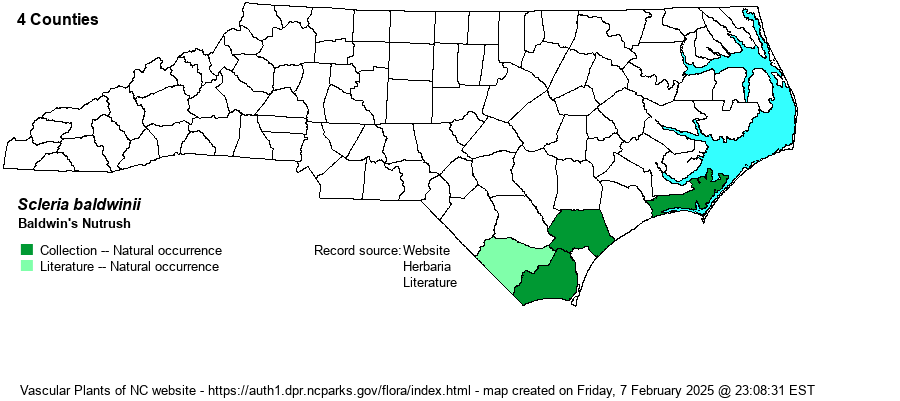| Author | (Torrey) Steudel | |
| Distribution | Southern outer Coastal Plain. Known only from Brunswick, Columbus, Pender, and Carteret counties.
Coastal Plain, NC to southern FL and southeastern TX; Bahamas, Cuba. | |
| Abundance | Rare. The NCNHP database lists only 8 records, all extant, with 3-4 still in good condition, suggesting a State Rank closer to S1S2 than to a straight S2, and the NCNHP did (in late 2022) move the State Rank from S2 to now S1S2. This is a State Threatened species. | |
| Habitat | Depressions in wet pine savannas and flatwoods, often with Pond Pine (Pinus serotina) and Pond Cypress (Taxodium ascendens). |
| Phenology | Flowering and fruiting June-July. | |
| Identification | This is a robust nutrush, having a stem up to 3 feet tall, from a thick, knotty, horizontal rhizome. The spikelets are in a terminal cluster, with a long erect bract that appears as a continuation of the stem. It is similar to Georgia Nutrush (S. georgiana), but is larger in almost all respects, including the seeds (3-4 mm long vs. 2-3 mm long in that species). | |
| Taxonomic Comments | None
The genus Scleria, named as nutrushes, is a group of sedges notable for the white, often glossy, achenes (seeds) and tough, knotty, horizontal rhizomes (absent in S. verticillata, S. muehlenbergii, and S. reticularis). Stems are 1-many per plant, terminated by inflorescences of 1-several spikelets, subtended by leafy bracts. In some species there are also inflorescences produced from upper and middle stem leaf axils, these usually on long arching stalks. A dissecting scope is necessary to examine the achene for shape, ornamentation (bumps, pits, ridges), and hairs. Just as important are features of the hypogonium, upon which the achene tightly sits: present or not, how many lobes, and ornamentation (bumps, sharp points, etc.). | |
| Other Common Name(s) | None | |
| State Rank | S1S2 | |
| Global Rank | G5? | |
| State Status | T | |
| US Status | | |
| USACE-agcp | FACW link |
| USACE-emp | | |

